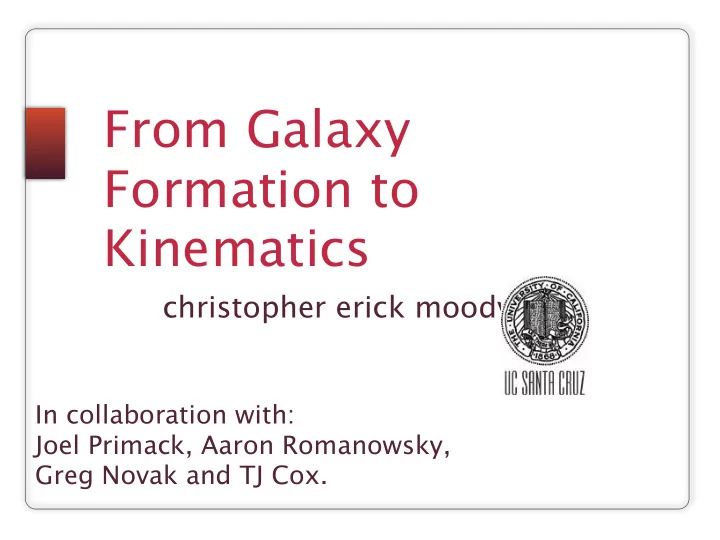

From Galaxy Formation to Kinematics christopher erick moody In collaboration with: Joel Primack, Aaron Romanowsky, Greg Novak and TJ Cox.
SAURON / ATLAS 3D Fast rotator Anisotropy diagram “rotation”= Fas λ Slow rotator Slo ellipticit =“projected shape” • Fast rotators are above the isotropic, oblate rotator line • Slow rotators are not scaled-down fast rotators • More massive • Round, have ϵ ~ 0.0-0.2 How do slow rotators form? (Emsellem et al. 2011)
Simulated Binary Mergers • Simulated binary mergers and remergers with varying mass ratios, initial conditions, and orbital parameters at high resolution • Form galaxies with λ <0.1, λ but are far too elongated ϵ =0.0-0.4 ϵ → Do not form slow & round rotators in binary simulations (Bois et al. 2011)
Simulated Multiple Repeated mergers • Bournaud et al. 2007 simulated 10 1:10 mergers, 5 1:5 mergers, etc. • Multiple mergers decrease remnant v/ σ , form rounder f v/ σ o r e remnants b m • Results are independent of mass u n g ratio; only dependent on remnant n i s a s mass e r e r c g n r e I m 0.1 ellipticity → Did not reach slow or round rotators, but there is a trend towards slow/round with multiple mergers (Bournaud et al. 2007)
Simulations: Progenitors Model spiral galaxies • All late-type galaxy models • Designed to model SDSS galaxies • D, Y, Z series are bulgeless • G3, G2, G1, G0 in order of f gas descending mass • G3 also a gas fraction series • G3BL is a G3 without a bulge (not shown) • Sbc series have small bulges log stellar mass (B/D ∝ size of blue circle) → Progenitors cover a range of gas fractions (‘gf’) and mass ranges, and may be bulgeless (‘BL’)
Schematic: Assembly Binary mergers Sequential mergers Remergers • Two progenitors • Either G2 or G1 • Either G2 or G1 • Minor, major • Either 4 or 8 • Also, 4 and 8 mergers overlapping major+ progenitors • R peri , ϵ , • Every merger a is minor mergers always a remerger Randomly chosen initial orientations, Cosmologically- impact parameters. Idealized simulations. motivated orbits. Not statistical.
With increasing gas fraction: faster rotators, higher ellipticity rotation - Increasing gas fraction λ dispersio n- supporte round elongate ellipticit
Binary Mergers: Orbital Variations λ ellipticit • Varying orbital initial conditions: • Spin (pro/retrograde), varying pericenter, orbital ellipticities • Only specially constructed initial zero angular momentum case is a slow rotator - but quite elongated
Multiple mergers: Major vs. minor Major (re)mergers Minor (sequential) mergers λ λ ellipticit ellipticit • Both sets of simulations have same number of identical progenitors • Multiple minor merger remnants are slower and rounder
Misalignments • Fast rotators ~5° • Slow rotators 0°-90° λ SAURO photometric- kinemetric • SAURON and simulations in good agreement (Emsellem et al. 2007)
Kinematic Classification • ATLAS 3D finds kinematically decoupled Slow cores and other non regular rotators with high frequency in their slow rotator sample • How do these features arise? • 82% Fast Rotators • 17% Slow Rotators, many with either KDC Fast or CRC features ATLAS 3D Kinematic Classification (Krajnovi ć et al. 2011)
Polar orbits yield fast rotators but also KDCs Face on velocity • Polar orbits impart significant Fiducial momentum out of the plane of the progenitor galaxy Fiducial Polar0 Polar0
Sequential Merger KDCs 4xG2 Face-on 8xG1 Face-on Velocity Velocity X/R e fg X/R e fg X/R e fg X/R e fg • Small-scale KDCs present in many velocity maps for sequential series • Major mergers result in a more disrupted remnant kinematic structure
Overall kinematic twist incidences t i b r o r a l o m p u y t l n l a e t m o t o m y r r a a l u n g n i b a l a i t i n i o r e z e l p i t l u m • Multiple mergers have KT rates of 20%-90% • Binary mergers have KT <30% , with exceptions
Conclusions • Binary mergers generically form fast rotators • Slow rotators are in general not formed in dissipational binary major mergers. The exceptions depend on unique initial conditions: } still quite • Bulgeless galaxies that are essentially dry mergers • Zero initial angular momentum elongated • Sequential multiple mergers can form round slow rotators • Kinematic twists much more prevalent in polar orbits and slow rotators
Overall Trends (averaged over all projections) < λ y r a n i b e l p i t l u m
Multiple Mergers Semi-analytic model SDSS mass function predictions 10 E fg ective number Numbe of r progenito density rs stellar mass log stellar mass • Spiral progenitors are at least 1:10 stellar mass ratio • E fg ective number of progenitors is mass-weighted • Semi-analytic models predict that the most massive systems form by multiple mergers • Multiple, minor mergers are a relevant scenario (Left: Bell et al. 2003, Right: de Lucia et al. 2006)
Title • (Cites)
Simulation parameters Extra (Covington 2008, Cox 2004, Cox et al. 2006)
Simulation parameters Extra (Covington 2008, Cox 2004, Cox et al. 2006)
Recommend
More recommend